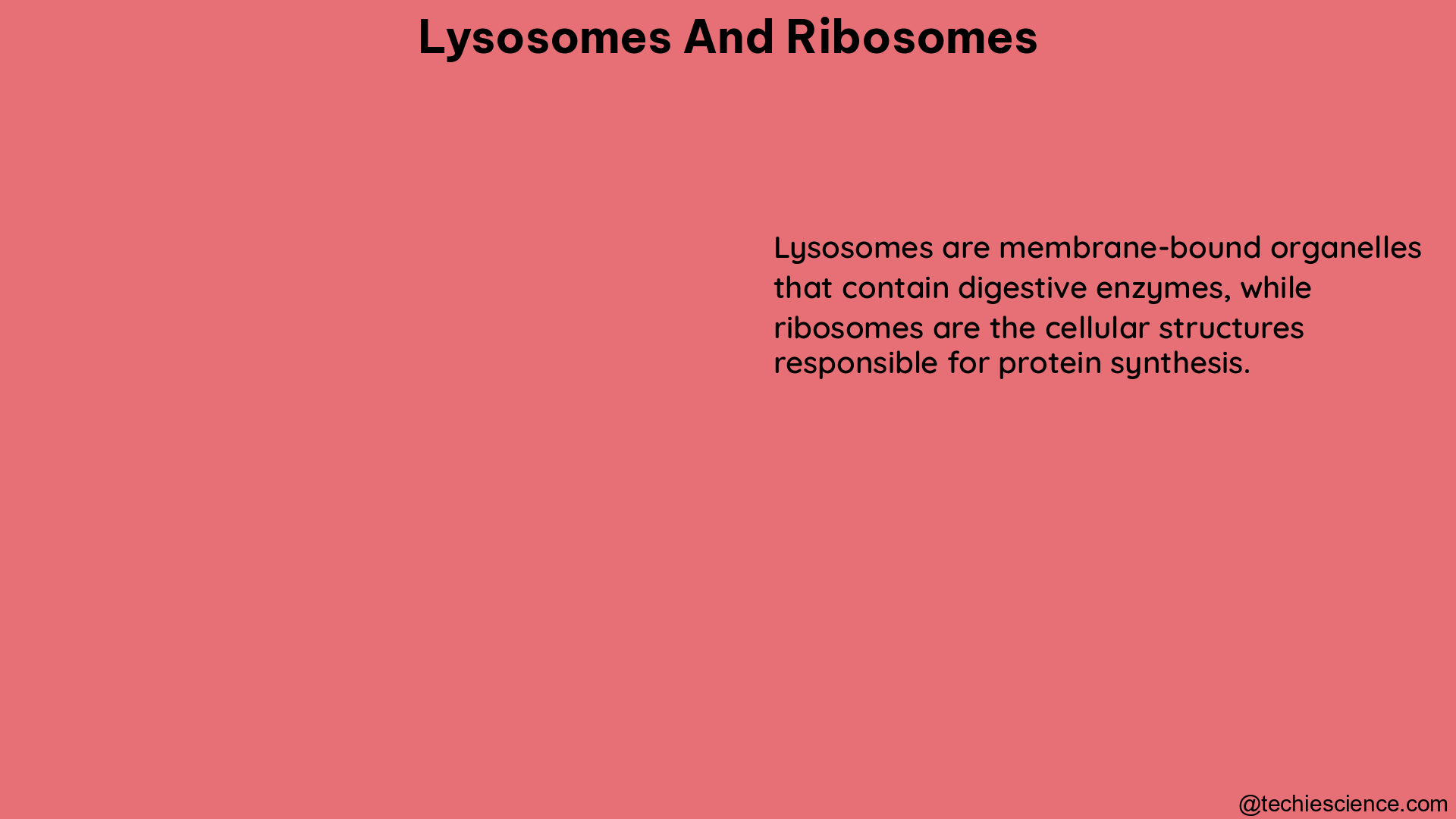Lysosomes and ribosomes are two of the most critical organelles in eukaryotic cells, playing vital roles in cellular degradation, recycling, and protein synthesis. Understanding the measurable and quantifiable characteristics of these organelles is crucial for researchers studying cellular function, disease mechanisms, and therapeutic interventions. In this comprehensive guide, we will delve into the intricate details of lysosomes and ribosomes, exploring their morphology, positioning, motility, function, structure, biogenesis, and protein synthesis rate.
Lysosomes: The Cellular Recycling Centers
Lysosomes are membrane-bound organelles that serve as the primary degradation and recycling centers within eukaryotic cells. These specialized compartments contain a diverse array of hydrolytic enzymes capable of breaking down a wide range of biomolecules, including proteins, lipids, and nucleic acids.
Lysosome Morphology
Lysosomes exhibit a remarkable diversity in size and number, which can be quantified using various microscopy techniques:
- Electron Microscopy: Transmission electron microscopy (TEM) and scanning electron microscopy (SEM) allow researchers to measure the diameter and volume of individual lysosomes, with typical sizes ranging from 0.5 to 1.5 micrometers.
- Confocal Microscopy: This high-resolution imaging technique enables the quantification of lysosome frequency, with studies reporting an average of 50 to 500 lysosomes per cell, depending on the cell type and physiological state.
- Super-Resolution Microscopy: Advanced techniques like stimulated emission depletion (STED) microscopy and structured illumination microscopy (SIM) can provide even more detailed information on lysosomal morphology, including the visualization and measurement of intricate substructures within these organelles.
Lysosome Positioning and Motility
The spatial organization and movement of lysosomes within the cell are crucial for their proper function and integration with other cellular processes.
- Positioning: Fluorescence microscopy and correlative light-electron microscopy (CLEM) techniques can quantify the distance between lysosomes and the nucleus or other organelles, revealing insights into their strategic positioning within the cell.
- Motility: Live-cell imaging methods, such as total internal reflection fluorescence (TIRF) microscopy and spinning disk confocal microscopy, allow researchers to measure the speed, directionality, and transport dynamics of lysosomes, providing valuable data on their intracellular trafficking.
Lysosomal Function
Lysosomes’ primary function is to degrade and recycle cellular components, and various methods can be used to quantify this activity:
- Enzyme Activity Assays: Fluorogenic or colorimetric substrates can be used to measure the activities of specific lysosomal enzymes, such as cathepsins, acid phosphatases, and β-hexosaminidases, which serve as indicators of lysosomal function.
- pH Measurement: Fluorescent pH-sensitive dyes or genetically encoded pH sensors can be used to monitor the acidic environment within lysosomes, which is crucial for the optimal activity of lysosomal hydrolases.
- Cargo Delivery Assays: Fluorescence-based techniques can track the delivery and degradation of specific cargo molecules within lysosomes, providing insights into their cargo processing capabilities.
Ribosomes: The Protein Synthesis Factories

Ribosomes are the cellular organelles responsible for the synthesis of proteins, the fundamental building blocks of life. Understanding the structure, biogenesis, and functional capacity of ribosomes is essential for unraveling the complexities of cellular protein production.
Ribosome Structure
Ribosomes are large, complex macromolecular assemblies composed of ribosomal RNA (rRNA) and numerous ribosomal proteins. The structure of ribosomes can be visualized and quantified using advanced electron microscopy techniques:
- Cryo-Electron Microscopy (Cryo-EM): This high-resolution imaging method allows researchers to determine the overall shape, size, and subunit composition of ribosomes, with the mammalian 80S ribosome measuring approximately 25 nanometers in diameter.
- Single-Particle Cryo-EM: This technique can provide detailed structural information on the various subdomains and functional centers within the ribosome, enabling a deeper understanding of its intricate architecture.
Ribosome Biogenesis
The process of ribosome biogenesis, which involves the assembly, maturation, and degradation of ribosomes, can be quantified using specialized techniques:
- Ribosome Profiling: This method combines ribosome footprinting with high-throughput sequencing to provide a global analysis of ribosome assembly, maturation, and turnover rates, offering insights into the dynamics of ribosome biogenesis.
- Pulse-Chase Experiments: By labeling newly synthesized ribosomal components with radioactive or fluorescent tags, researchers can track the kinetics of ribosome assembly and degradation, providing quantitative data on ribosome biogenesis.
Protein Synthesis Rate
The rate of protein synthesis, a key function of ribosomes, can be measured using various techniques:
- Metabolic Labeling: Incorporating modified amino acids, such as L-azidohomoalanine (AHA) or O-propargyl-puromycin (OPP), into newly synthesized proteins allows researchers to quantify the overall rate of protein synthesis.
- Pulse-Chase Experiments: By pulsing cells with labeled amino acids and then chasing with unlabeled amino acids, researchers can measure the kinetics of protein synthesis and turnover, providing insights into the functional capacity of ribosomes.
By leveraging these diverse methodologies, researchers can gain a comprehensive understanding of the measurable and quantifiable characteristics of lysosomes and ribosomes, enabling them to uncover the intricate mechanisms underlying cellular function, disease pathogenesis, and potential therapeutic interventions.
References:
- Barral Duarte C. et al., Current methods to analyze lysosome morphology, positioning, motility and function. Traffic, 2022. https://onlinelibrary.wiley.com/doi/10.1111/tra.12839
- LysoQuant: A deep learning approach for quantification of organelles and cargo delivery within endolysosomes. Mol Biol Cell, 2020. https://www.molbiolcell.org/doi/10.1091/mbc.E20-04-0269
- Current methods to analyze lysosome morphology, positioning, motility and function. Nat Methods, 2022. https://www.ncbi.nlm.nih.gov/pmc/articles/PMC9323414/
- Endoplasmic Reticulum, Golgi Apparatus, and Lysosomes. Learn Science at Scitable, Nature. https://idp.nature.com/authorize?client_id=grover&redirect_uri=https%3A%2F%2Fwww.nature.com%2Fscitable%2Ftopicpage%2Fendoplasmic-reticulum-golgi-apparatus-and-lysosomes-14053361%2F&response_type=cookie
- Methods for the functional quantification of lysosomal membrane permeabilization: a hallmark of lysosomal cell death. Nat Protoc, 2020. https://www.ncbi.nlm.nih.gov/pmc/articles/PMC7611294/
- Single-particle cryo-EM structure of the mammalian 80S ribosome. Nature, 2015. https://doi.org/10.1038/nature14557
- Global analysis of mammalian ribosome biogenesis by ribosome profiling. Nature, 2012. https://doi.org/10.1038/nature11182
- Metabolic labeling of RNA with 4-thiouridine enables transcript-level measurements of RNA synthesis and decay. Nat Protoc, 2011. https://doi.org/10.1038/nprot.2011.427
- Pulse-chase analysis of protein synthesis and turnover in mammalian cells. Nat Protoc, 2006. https://doi.org/10.1038/nprot.2006.89
Hi, I am Sayantani Mishra, a science enthusiast trying to cope with the pace of scientific developments with a master’s degree in Biotechnology.